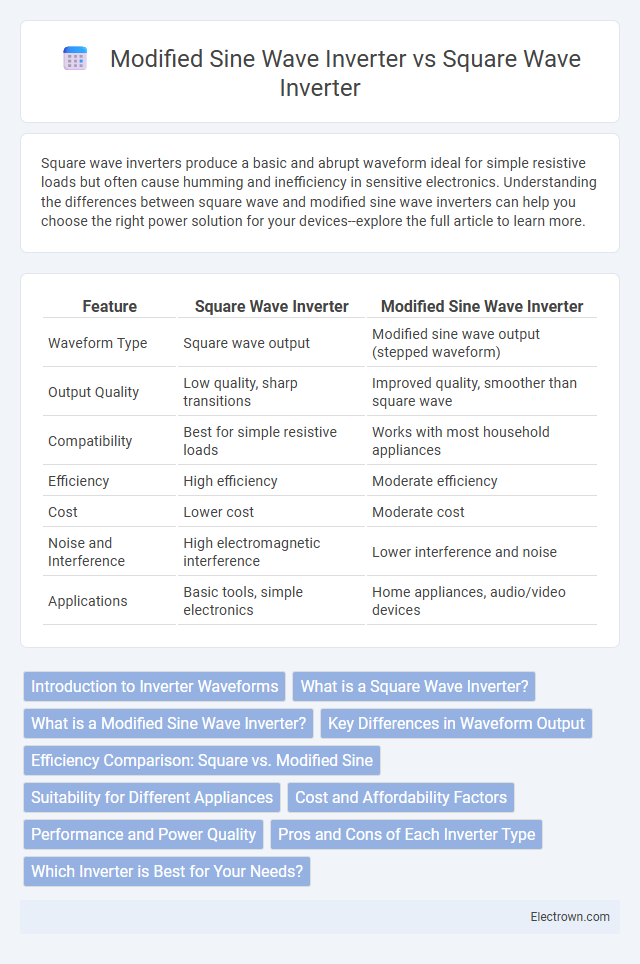Square wave inverters produce a basic and abrupt waveform ideal for simple resistive loads but often cause humming and inefficiency in sensitive electronics. Understanding the differences between square wave and modified sine wave inverters can help you choose the right power solution for your devices--explore the full article to learn more.
Table of Comparison
| Feature | Square Wave Inverter | Modified Sine Wave Inverter |
|---|---|---|
| Waveform Type | Square wave output | Modified sine wave output (stepped waveform) |
| Output Quality | Low quality, sharp transitions | Improved quality, smoother than square wave |
| Compatibility | Best for simple resistive loads | Works with most household appliances |
| Efficiency | High efficiency | Moderate efficiency |
| Cost | Lower cost | Moderate cost |
| Noise and Interference | High electromagnetic interference | Lower interference and noise |
| Applications | Basic tools, simple electronics | Home appliances, audio/video devices |
Introduction to Inverter Waveforms
Square wave inverters generate a basic waveform with abrupt voltage transitions, suitable for simple resistive loads but often incompatible with sensitive electronics. Modified sine wave inverters produce a stepped waveform that approximates a sine wave, offering improved efficiency and compatibility with most household appliances. Understanding these waveforms is crucial for selecting the right inverter based on load requirements and efficiency needs.
What is a Square Wave Inverter?
A square wave inverter converts direct current (DC) into an alternating current (AC) output with a simple, abrupt waveform that switches instantly between positive and negative voltage levels. This type of inverter is less expensive and easier to design but produces a waveform with higher harmonic distortion, which can damage sensitive electronic devices or cause inefficiencies. Square wave inverters are typically used for basic applications where power quality is not critical, such as simple motor loads or resistive heating elements.
What is a Modified Sine Wave Inverter?
A Modified Sine Wave Inverter produces an output waveform that approximates a sine wave by combining a series of stepped voltage pulses, creating a more efficient and cost-effective alternative to pure sine wave inverters. This type of inverter is suitable for powering most household electronics, including simple motors and lights, but may cause humming or reduced efficiency in sensitive equipment. Modified sine wave inverters typically offer a balance between affordability and functionality, making them popular for basic power inverters used in RVs, backup power, and simple renewable energy systems.
Key Differences in Waveform Output
Square wave inverters produce a simple on-off waveform with abrupt transitions between high and low voltage levels, leading to a blocky, less smooth output that can cause noise and inefficiency in sensitive electronics. Modified sine wave inverters approximate a sine wave with stepped transitions, providing a waveform that is closer to true sine wave output and results in improved performance for most household appliances and reduced electromagnetic interference. Your choice between these inverters hinges on the compatibility requirements of your devices, with modified sine wave inverters generally offering better waveform quality for a broader range of applications.
Efficiency Comparison: Square vs. Modified Sine
Modified sine wave inverters typically offer higher efficiency than square wave inverters by producing cleaner power that reduces harmonic distortion and energy loss in devices. Square wave inverters generate more heat and electromagnetic interference due to their abrupt voltage transitions, leading to lower overall system efficiency. Efficiency rates for modified sine wave inverters often range from 85% to 95%, while square wave inverters generally fall between 70% and 85%.
Suitability for Different Appliances
Square wave inverters suit simple resistive loads like incandescent bulbs and basic power tools but can cause overheating or inefficiency in electronic devices. Modified sine wave inverters provide a waveform closer to pure sine, making them better for sensitive electronics, appliances with electric motors, and audio or video equipment. Choosing the right inverter type depends on appliance complexity and power quality requirements to avoid malfunctions and ensure optimal performance.
Cost and Affordability Factors
Square wave inverters typically offer lower upfront costs compared to modified sine wave inverters, making them more affordable for budget-conscious users. The simplicity of square wave inverter design reduces manufacturing expenses but may cause compatibility issues with sensitive electronics. Modified sine wave inverters, while slightly more expensive, provide better performance and efficiency, justifying the higher price for many households and small businesses.
Performance and Power Quality
Square wave inverters produce a simple, abrupt waveform that often causes higher harmonic distortion, reducing power quality and potentially damaging sensitive electronic devices. Modified sine wave inverters generate a stepped waveform closer to a pure sine wave, resulting in improved performance with less noise and better compatibility for most household appliances. Your choice impacts power efficiency and device longevity, with modified sine wave inverters generally offering superior power quality and smoother performance.
Pros and Cons of Each Inverter Type
Square wave inverters are simple and cost-effective, suitable for resistive loads but tend to produce more harmonic distortion, reducing efficiency and potentially damaging sensitive electronics. Modified sine wave inverters offer a better approximation of pure sine wave output, improving compatibility with a wider range of devices, but still generate some harmonics that can cause noise in audio equipment and reduced motor efficiency. Choosing between the two depends on balancing budget constraints with the need for clean power output and device compatibility.
Which Inverter is Best for Your Needs?
Square wave inverters are best suited for simple, resistive loads like incandescent bulbs and basic power tools, while modified sine wave inverters handle a wider range of devices, including many household electronics with improved efficiency and reduced noise. Your choice depends on the type of appliances you need to power; sensitive electronics, such as laptops or audio equipment, perform better with modified sine wave inverters. Consider the complexity of your devices and the quality of power output required to determine which inverter aligns with your energy needs.
square wave inverter vs modified sine wave inverter Infographic

 electrown.com
electrown.com